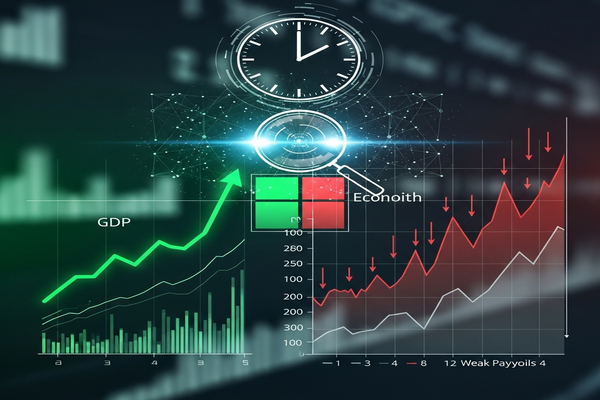
GDP growth is running hot while payrolls have cooled, and that disconnect is driving market attention today. Strong GDP readings, powered by large investments in AI data centers and software, contrast with average monthly job gains near 27,000 in recent months. In the short term the question is whether the labor market or output will converge. Globally, the signal matters for US policy, for European growth expectations, and for Asian exports tied to tech capex. Historically, such divergence does not last long, so traders are watching corporate reports and Fed commentary for signs of which way the gap will close.
Opening market snapshot for the trading session
Markets start the day with a clear focus. Equities are parsing robust headline GDP metrics against soft payrolls. Credit and bond desks are weighing whether the labor market weakness justifies lower rates over time or is a temporary supply issue. Corporate earnings and CEO anecdotes now act as near real time signals while some official government releases remain delayed. Traders are leaning into sector dispersion. Technology names tied to AI infrastructure chipmakers and cloud operators may see different flows than cyclicals such as autos and industrials. Consumer staples that sell premium products could behave differently than mass market brands.
Why GDP looks strong and what is actually driving it
GDP printed a 3.8 percent annualized gain in Q2, and the Atlanta Fed’s GDPNow model is tracking about 3.9 percent for Q3. The boost comes in large part from heavy investments in AI-related data centers and enterprise software buildout. That capex is accelerating demand for servers, networking equipment, and cloud services. Historically, surges in investment of this scale lift measured output quickly. However, output gains driven by investment can be front loaded and may not translate immediately into broad hiring.
Why payrolls have lagged and how that shapes market psychology
Payroll growth averaged just 27,000 a month from May through August, a pace that has typically appeared only near recessions or recoveries. Yet the unemployment rate has held steady during this period. The mismatch raises two plausible readings. One view is that labor demand has softened and output measures are too optimistic. Goldman Sachs (NYSE:GS) economists cite consumer sentiment data showing unusually negative unemployment expectations outside recessions. That pattern can erode confidence and weigh on consumption if it persists. An alternative view attributes weak payrolls to a tighter labor supply because of immigration policy, tariff-related one-time adjustments by firms, and productivity gains from AI. In that scenario firms could be producing more without hiring as many workers immediately.
Corporate anecdotes and consumer spending signals
With some official data delayed, corporate reports provide an early gauge of demand. General Motors (NYSE:GM) posted better-than-expected results driven by pickup truck demand. The company said tariffs might cost up to $4.5 billion this year but that the expected hit is below prior estimates and management believes it can offset more than a third of the cost. GM also suggested next year may look stronger than 2025 for the auto cycle.
Coca-Cola (NYSE:KO) reported continued strength in no-sugar beverages and in protein shakes such as Fairlife. Executives noted that premium brands like Topo Chico and Fairlife are holding up as lower-income consumers show more restraint. That divergence in spending between income groups helps explain why headline retail demand can remain firm even as broader sentiment sours. These anecdotes point to uneven consumer resilience where higher-income spending supports certain categories while others slow.
Scenarios traders will watch and near-term market implications
Markets are essentially pricing two convergence paths. One path has economic growth cooling to match the weak payrolls reading. That outcome would reduce pressure on rates and could lift fixed income. The other path has the labor market rebounding as firms respond to confirmed demand and as labor supply adjusts. That path would increase the odds of durable growth and sustain demand for cyclicals and tech capital goods. In the middle lie hybrid outcomes where productivity gains from AI reduce long run hiring needs even as output keeps rising.
For the current session, key signals will come from further corporate commentary on tariffs, capex plans, and hiring intentions. Fed comments will be parsed for whether officials view the data conflict as temporary. Traders will also watch consumer sentiment and any follow up on payrolls and unemployment to see whether expectations about labor risk continue to deteriorate. Global flows matter too. Strong US investment in AI hardware supports exports to Asia and helps European suppliers of data center components, while weaker hiring can dim demand for services that underwrite euro area growth.
Overall, the immediate takeaway is simple. The contrast between robust output and tepid hiring creates market uncertainty that sharpens sensitivity to corporate reports and Fed dialogue. That makes today’s earnings color and any fresh labor market signals especially relevant for positioning across equities, credit, and rates.












